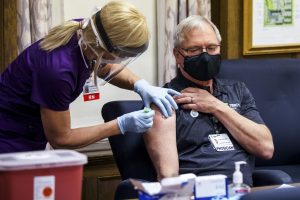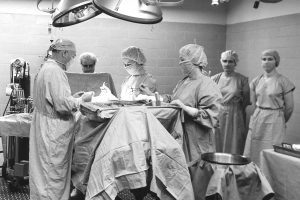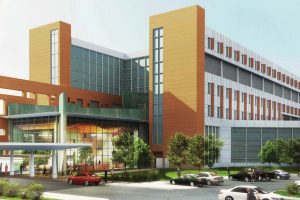
A 1931 issue of Trinity Hospital News didn’t sugarcoat the problem: “It is not news by this time to say that we are in the throes of one of the worst financial depressions in several generations. With money scarce, it has become difficult even to collect for the service we render.”
The article describes a sharp rise in the number of extreme cases of illness – a direct result of the financial depression. “People just do not go to the doctor or to the hospital until they feel that they must.”
Then comes this admission: “The aggravated illness of such a large number of patients has created a new nursing problem – extremely ill patients require a great deal more care than one who is not so critically ill. The result is a nursing problem which makes a heavy drain upon the nursing staff.”
Those words have a familiar ring.
 The coronavirus pandemic that wreaked havoc on the healthcare industry worldwide may be the greatest challenge Trinity Health has faced since those days of the Great Depression. A multivolume book could be written about the daily battles Trinity Health’s leaders and care teams waged. When would the anticipated surge in COVID-19 patients arrive? Would staffing levels be enough? Would the supply chain hold up? What community partners could be enlisted, and would staff have the courage to keep going?
The coronavirus pandemic that wreaked havoc on the healthcare industry worldwide may be the greatest challenge Trinity Health has faced since those days of the Great Depression. A multivolume book could be written about the daily battles Trinity Health’s leaders and care teams waged. When would the anticipated surge in COVID-19 patients arrive? Would staffing levels be enough? Would the supply chain hold up? What community partners could be enlisted, and would staff have the courage to keep going?
In a series of letters to employees and the community, Trinity Health President and CEO John Kutch took a cue from his 1931 predecessor and didn’t flinch from truth-telling: “We are gaining patients … and losing patience. Our medical teams have heroically fought this battle. Their physical, emotional and mental bandwidth has been stretched to the brink.”
He also reinforced employees’ sense of purpose: “Why do we do this? Our community needs us. Like we have done during floods, an anhydrous explosion, and so many other trials, we will do what it takes to provide excellent healthcare for our neighbors, families, and communities. We will prevail – together.”
A Through Line Through History
 If there is one line that runs through Trinity Health’s 100-year history, it is a sense of purpose, buoyed by an indomitable spirit. Whether problems involved staff shortages, space issues, regulatory demands, rising costs, cuts in government reimbursement, or a pandemic, Trinity Health has always summoned its own strength and that of the community to carry the day.
If there is one line that runs through Trinity Health’s 100-year history, it is a sense of purpose, buoyed by an indomitable spirit. Whether problems involved staff shortages, space issues, regulatory demands, rising costs, cuts in government reimbursement, or a pandemic, Trinity Health has always summoned its own strength and that of the community to carry the day.
Nearly every one of Trinity’s 10 decades has been punctuated by a watershed moment aimed at taking the care system to the next level.
After World War II, veterans and war workers came streaming home, creating the greatest demand yet for hospital services. Trustee chairman Rev. Reinhardt Ulvilden declared, “Trinity is crowded beyond the danger point.” A $500,000 fund drive was launched for a six-story addition to the hospital’s east side.
The next decade produced problems that went beyond space and finances. Medical science after the war enjoyed a period of rapid advancement with orthopedics, rehabilitation medicine, and trauma care among the specialties that benefitted from the war experience. Trinity Health took stock of itself and found many of its facilities wanting. Essential services such as surgery, lab and x-ray were scattered throughout the six floors, making it difficult to respond to emer- gencies like the Westland Oil fire in the late 1940s. In 1954, Trinity’s Board of Trustees embarked on a major construction program to expand and modernize Trinity Hospital. Two of its members, H. H. Westlie and Theodore Thompson, led a regional campaign. Close to 1,000 volunteers were organized in seven divisions to do the actual solicitations for gifts and pledges. It was the biggest fund drive ever attempted in North Dakota, according to The Minot Daily News.
At ceremonies dedicating the new addition, American Hospital Association President Russell Nelson, MD, who trained at Trinity, congratulated the community:
“Look for the scientific and treatment facilities—the surgical operating rooms, the laboratories, the x-ray department and many other special things. Here is where you find the modern hospital, the future hospital.”
The modernized hospital sustained a high level of care for many years, but the explosion in technology and medical innovation created the need for one more building expansion before the turn of the century. A $13.8 million renovation and expansion project provided crucial features – a redesigned surgery complex, expanded radiology department, and a new south entrance. It paved the way for fiber optics and minimally invasive surgeries, and the coming digital revolution. At the project’s 1984 dedication, Board Chairman Chester Reiten summed it up well: “We’ve never stood still,” he said.
A 21st Century Regional Care System
 Today, Trinity Health is on the verge of its greatest achievement yet – a healthcare campus and medical district that will vault Trinity beyond its original walls and into the next century. Slated to open in 2023, the new campus will serve as a model for a 21st century regional care system. At the 2018 groundbreaking, Mr. Kutch called the venture the biggest change yet in Trinity’s history. “What hasn’t changed is our commitment to always look ahead and improve ourselves in ways that will provide the most exceptional care possible for our patients, their families, and the communities we serve.”
Today, Trinity Health is on the verge of its greatest achievement yet – a healthcare campus and medical district that will vault Trinity beyond its original walls and into the next century. Slated to open in 2023, the new campus will serve as a model for a 21st century regional care system. At the 2018 groundbreaking, Mr. Kutch called the venture the biggest change yet in Trinity’s history. “What hasn’t changed is our commitment to always look ahead and improve ourselves in ways that will provide the most exceptional care possible for our patients, their families, and the communities we serve.”
He is quick to point out, however, that a health system isn’t about bricks and mortar, it’s about people – the staff, physicians, managers, community partners, Board of Directors, and patients. By luck or by design, Trinity Health has managed to draw into its circle people with an indomitable spirit. Not only do they show up, they put up with brutal hours and unexpected setbacks. They study, read journals, train and retrain just to stay sharp. And they do it with a smile and a human touch.
Together, their efforts have echoed through Trinity Health’s history, serving as living proof that if you do the right things every day, you’ll make it to 100 and then some.
